.
1.06.2015
The SONC prepares the wake of Philae
.
The fourth period of attempts to contact Philae may be good, believe Cédric Delmas, responsible for the operations SONC and Eric Jurado, responsible for activities in space mechanics SONC. They return to activities at the Science Operation Center & Navigation CNES in Toulouse to prepare this revival.
.
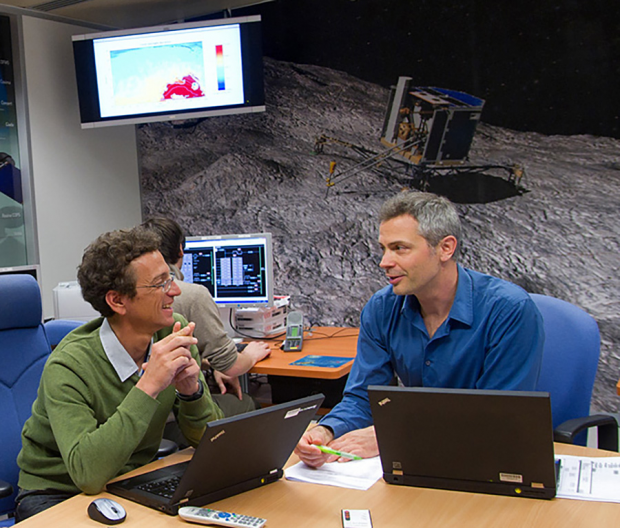
Eric Jurado, responsible for activities in space mechanics SONC, and Cedric Delmas, responsible for the SONC operations. Credits: CNES / E. Grimault, 2014.
More than seven months after the landing of Philae on the core of Comet 67P / Churyumov-Gerasimenko, the activity is still intense in SONC (Science & Navigation Operation Center) installed in the building Descartes CNES in Toulouse, and space mechanics team is heavily involved in attempts to repeatedly contact Philae?
Cédric Delmas: "Sure. The space mechanics SONC team determines the best times to that Rosetta is trying to pick up the signal of Philae. In better times, means the period during which the orbiter is in the field of view of Philae antennas when the solar panels of the landing gear are most likely illuminated by the Sun and that it should have sufficient energy to communicate. "
But is there not a problem of distance between Rosetta and Philae?
Eric Jurado: "Following the recent problems navigation by the orbiter, it was a bit far from the core to protect it from the effects of the increasing activity at the approach of the Sun, but we are still largely in the limited in terms of distance. In fact, if the communication is obviously a bit more difficult between the orbiter and Philae when it moves away, it is still possible to over 200 km. "
Cédric Delmas: "We have made calculations that show that Philae could even communicate with Rosetta 400 km of distance; the only consequence would be the duration of effective communication that would be much shorter at each window. "
Hence the importance of knowing the orientation of Philae to the ground to determine with the greatest possible precision potential niche communications?
Eric Jurado: "Yes, but of course we are taking margins, we do not try to communicate only during those moments, we cover broader periods. "
How many he has had communication attempts periods between the orbiter and Philae?
Cédric Delmas: "We are in 3 periods of communications attempts. One in March, one in April and the third period ended May 20 We have a new program period that will begin in the coming days, May 30 normally. There has been no contact so far and I can say that we expected a bit for the first 2 periods that came very early compared to the possibilities of revival of Philae. Now the conditions seem more favorable so we think that a resumption of contact for this. "
.

Eric Jurado with several members of the space mechanics team SONC. Credits: CNES / G. Cannat, 2014.
This awakening of Philae dependent on its precise position on the nucleus and its orientation, have you made progress on these points?
Eric Jurado: "What we can say today is that, thanks to CONSERT data and OSIRIS ROMAP mainly, but also thanks to the information provided by CIVA ROMAP and ROLIS and enlightenment solar panels we know with an accuracy of less than 50 m the final landing point of Philae. We also know how the undercarriage is oriented relative to the surface. "
SONC of the teams they will do a scientific publication on the analysis of how the landing took place?
Eric Jurado: "We are currently conducting any work that will be useful to all scientists: it is a study on how Philae came down, he bounced back and how he finally landed, because scientists really need these data to better interpret measurements of their instruments. There has already had publications in technical journals and there will be an article soon in Science for which we are co-authors. "
Attention has focused on the many non-functioning harpoons and cold gas thruster during landing, causing multiple rebounds, but the precision obtained in the calculation of the trajectory by the team Space mechanics SONC was truly outstanding?
Eric Jurado: "Philae fell to around 120 m from the place in question and with less than a minute offset relative to the calculated trajectory, which is really good compared to what we expected. "
Cédric Delmas: "Remember, the ellipse of uncertainty for the landing was a major axis of about 800 m, so we were practically in the center! "
.
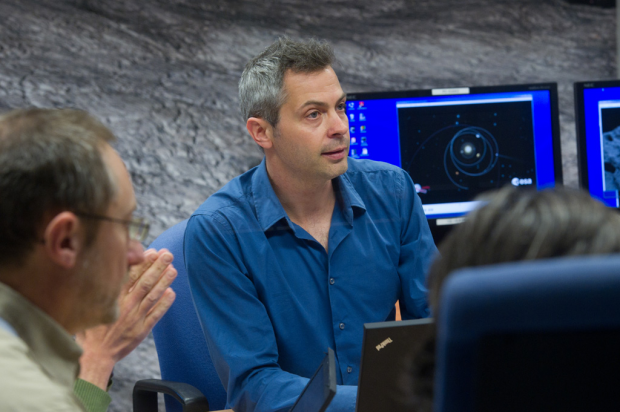
Cédric Delmas, responsible for operations of SONC, Science & Navigation Operation Center, CNES in Toulouse. Credits: CNES / E. Grimault, 2014.
If the contact is restored with Philae in the days or weeks, the SONC will again be first in line to manage the planning of scientific activities?
Cédric Delmas: "The teams SONC mobilized for months to redefine all the activities that could be done immediately after Philae will wake up. We must be prepared to send sequences of use of different scientific instruments as soon as possible. At present, we have established different scenarios to accommodate the environment Philae, its illumination, the energy level available to it, etc. The vast difference from what we had imagined before landing, is that we do not charge the battery, which would have allowed us to establish programs on the longer term. But we know that if Philae does not communicate, it is most likely because the solar panels do not provide enough electrical power for the battery can recharge. We are therefore preparing to work only during the local day, using solar energy directly, bypassing a storage phase. This is a mode of operation that we had not anticipated before landing and had to redefine all scientific activities taking into account these new constraints. "
So, do the instruments will be favored?
Cédric Delmas: "We are to redraw the sequences of use of instruments and we think the conditions deployments. If we wanted to use some instruments, such as APXS, we should first maneuver the body of Philae, bring it down closer to the surface. Similarly, for drilling with drill SD2, since it seems that one has "drilled into the void" in November, it would rotate the balcony of Philae. All this must be carefully studied to establish an order of priority. The idea is to do well at first activities that consume little power, like those of ROMAP or SESAME, and remake images with CIVA and ROLIS to study the immediate surroundings of Philae more accurately under a better lighting. In a second time, then we would consider moving on to more complex activities that implement mechanical elements with the risk of displacement of Philae to be taken into account. "
Quelle: CNES
.
Update: 2.06.2015
.
COMETWATCH 20 MAY
This image of Comet 67P/Churyumov-Gerasimenko was taken by Rosetta's NAVCAM on 20 May at a distance of 163.6 km from the comet centre. It is a single frame image with a resolution of 13.9 m/pixel, and measures 14.3 km across. The intensities and contrast have been adjusted to emphasise the activity of the comet.
.
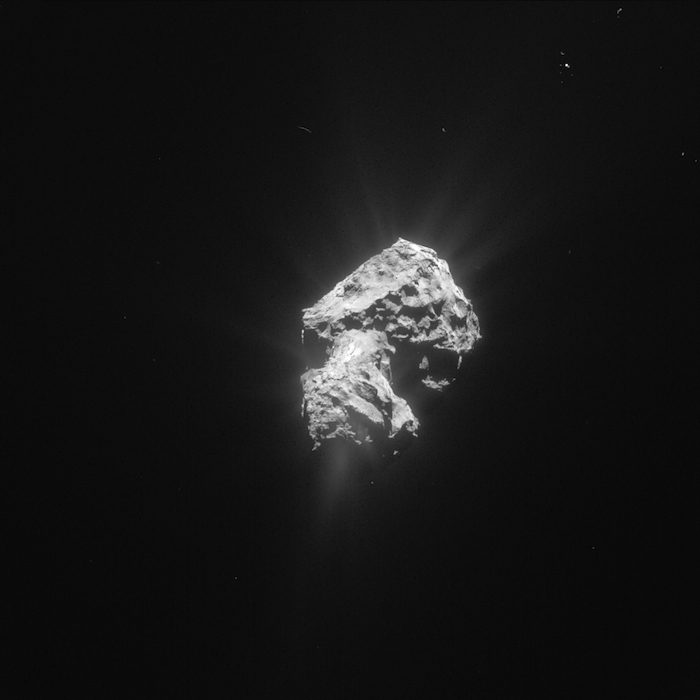
Processed image of Comet 67P/C-G taken by Rosetta's NAVCAM on 20 May 2015. Credits: ESA/Rosetta/NavCam – CC BY-SA IGO 3.0
.
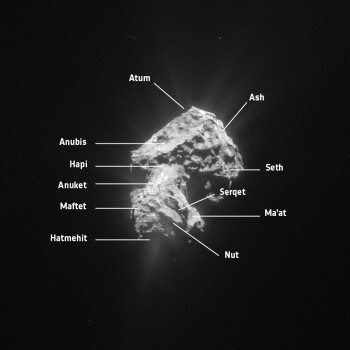
In this orientation, perhaps the most striking observation is the activity seen close to Hatmehit, the circular depression on the comet’s small lobe. There also appears to be activity associated with the Nut region, which lies below Serqet in this orientation. In both cases, the activity stands out against the shadowed portions of the comet in this area.
On the large lobe, the comet is oriented with the relatively smooth face of Anubis towards the top left, making a distinct boundary with the neighbouring rugged Seth region to the right.
In this view the comet also shows off the transition between the two lobes, with Anuket on the small lobe merging into Hapi at the neck.
The original 1024 x 1024 pixel image is provided below:
.

Quelle: ESA
-
Update: 3.06.2015
.
Alice instrument’s ultraviolet close-up provides a surprising discovery about comet’s atmosphere
SwRI-developed ultraviolet spectrograph is aboard Rosetta, the first spacecraft to study a comet up close
.
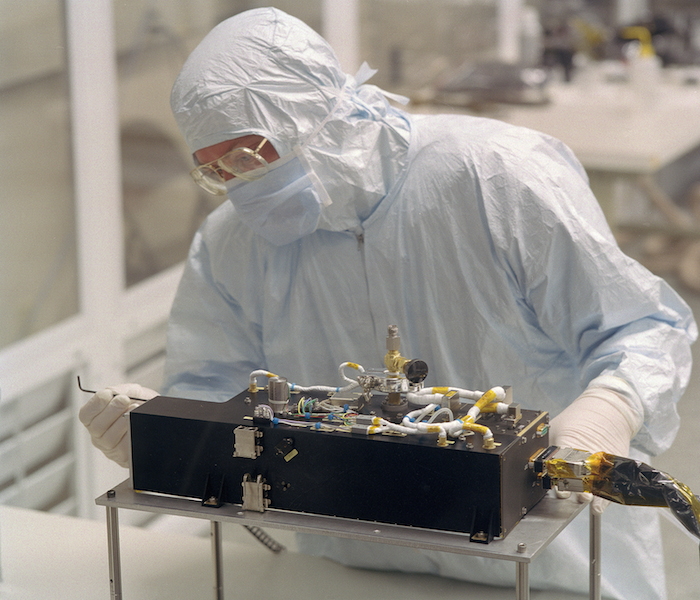
Image Courtesy of Southwest Research Institute
NASA's Alice ultraviolet (UV) spectrograph, seen here during construction, is aboard the European Space Agency's Rosetta spacecraft.
.
A close-up of Comet 67P/Churyumov-Gerasimenko by NASA’s ultraviolet instrument surprised scientists by revealing that electrons close to the comet’s surface ─ not photons from the Sun as had been believed ─ cause the rapid breakup of water and carbon dioxide molecules spewing from the surface.
Since last August, the European Space Agency’s Rosetta spacecraft has orbited within a hundred miles of the comet in this historic mission. The spectrograph onboard, named Alice, specializes in the far-ultraviolet wavelength band and was developed by Southwest Research Institute (SwRI). Alice examines light the comet is emitting to understand the chemistry of the comet’s atmosphere, or coma. A spectrograph is a tool astronomers use to split light into its various colors. Scientists can identify the chemical composition of gases by examining their light spectrum. Alice is the first such far-ultraviolet spectrograph to operate at a comet.
“The discovery we’re reporting is quite unexpected,” said Alice instrument Principal Investigator Dr. Alan Stern, an associate vice president in SwRI’s Space Science and Engineering Division. “It shows us the value of going to comets to observe them up close, since this discovery simply could not have been made from Earth or Earth's orbit with any existing or planned observatory. And, it is fundamentally transforming our knowledge of comets.”
“Analysis of the relative intensities of observed atomic emissions allows us to determine that we are directly observing the ‘parent’ molecules that are being broken up by electrons in the immediate vicinity, about 1 kilometer, of the comet’s surface from which the parent molecules are vaporizing,” said Dr. Paul Feldman, professor of physics and astronomy at the Johns Hopkins University in Baltimore, Maryland.
Feldman is lead author of the paper, “Measurements of the Near-nucleus Coma of Comet 67P/Churyumov-Gerasimenko with the Alice Far-ultraviolet Spectrograph on Rosetta,” which has been accepted for publication in the journal, Astronomy and Astrophysics.
Much of the water and carbon dioxide originates from “plumes” erupting from the comet’s surface, similar to those that the Hubble Space Telescope discovered on Jupiter’s moon Europa, noted co-author Dr. Joel Parker, an assistant director in SwRI’s Space Science and Engineering Division’s Boulder, Colo., office.
Based on the new Alice data reported in the paper, the explanation for the breakup of those molecules is similar to that for the plumes on Europa, except that the electrons at the comet are produced by solar radiation, while the electrons at Europa come from Jupiter’s magnetosphere, Feldman said.
Parker added, “By looking at the emission from hydrogen and oxygen atoms broken from the water molecules, we also can actually trace the location and structure of water plumes from the surface of the comet.”
The far-ultraviolet region of the spectrum allows scientists to detect the most abundant elements in the universe: hydrogen, oxygen, carbon and nitrogen. However, Feldman noted such measurements must be made from outside the Earth’s atmosphere, either from orbiting observatories such as the Hubble Space Telescope, or from planetary missions such as Rosetta. From Earth's orbit, the atomic constituents can only be seen after their “parent” molecules, such as water and carbon dioxide, have been broken up by sunlight, hundreds to thousands of kilometers away from the nucleus of the comet.
The Alice spectrograph aboard Rosetta has also studied the surface of Comet 67P/ Churyumov–Gerasimenko and will be used in further studies of its atmosphere as the comet approaches the Sun and its plumes become more active due to solar heating.
Rosetta-Alice is one of two ultraviolet spectrographs named “Alice” currently flying in space. The other is New Horizons-Alice. Rosetta-Alice is operated by SwRI under contract with the Jet Propulsion Laboratory/California Institute of Technology for the National Aeronautics and Space Administration. Alice is studying the coma and surface of Comet 67P/Churyumov–Gerasimenko to understand the formation and evolution of comets and the nature of cometary activity and to connect activity of the nucleus with changes in the coma and tail as well as interactions with the solar wind.
Quelle: Southwest Research Institute
---
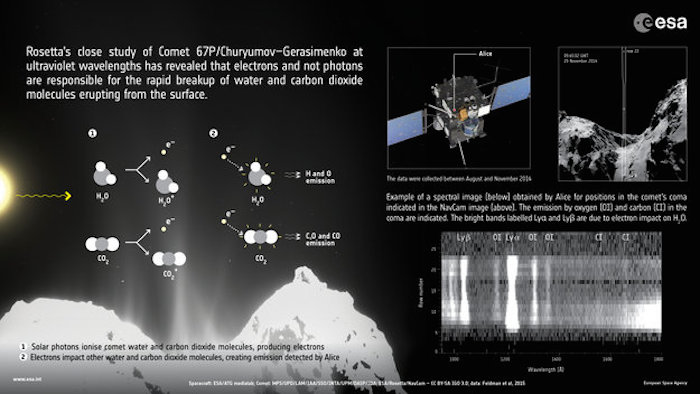
Rosetta’s continued close study of Comet 67P/Churyumov–Gerasimenko has revealed an unexpected process at work, causing the rapid breakup of water and carbon dioxide molecules spewing from the comet’s surface.
ESA’s Rosetta mission arrived at the comet in August last year. Since then, it has been orbiting or flying past the comet at distances from as far as several hundred kilometres down to as little as 8 km. While doing so, it has been collecting data on every aspect of the comet’s environment with its suite of 11 science instruments.
One instrument, the Alice spectrograph provided by NASA, has been examining the chemical composition of the comet’s atmosphere, or coma, at far-ultraviolet wavelengths.
At these wavelengths, Alice allows scientists to detect some of the most abundant elements in the Universe such as hydrogen, oxygen, carbon and nitrogen. The spectrograph splits the comet’s light into its various colours – its spectrum – from which scientists can identify the chemical composition of the coma gases.
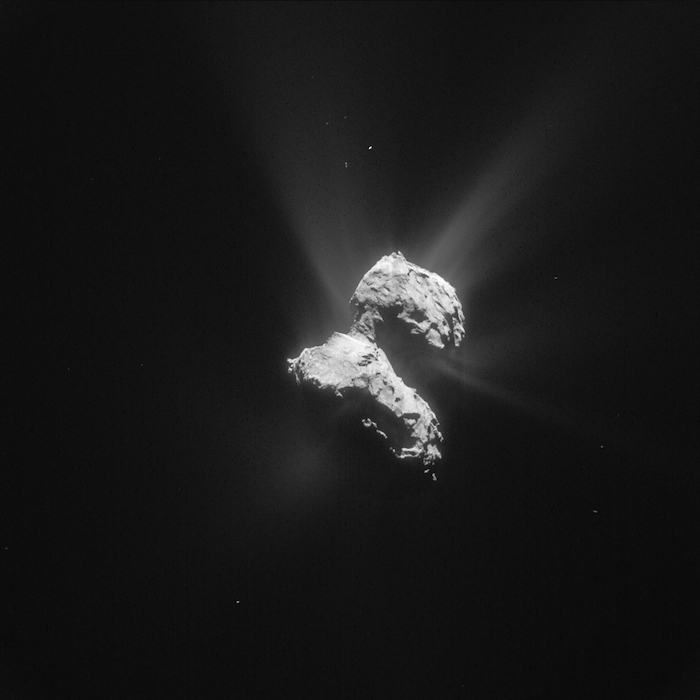
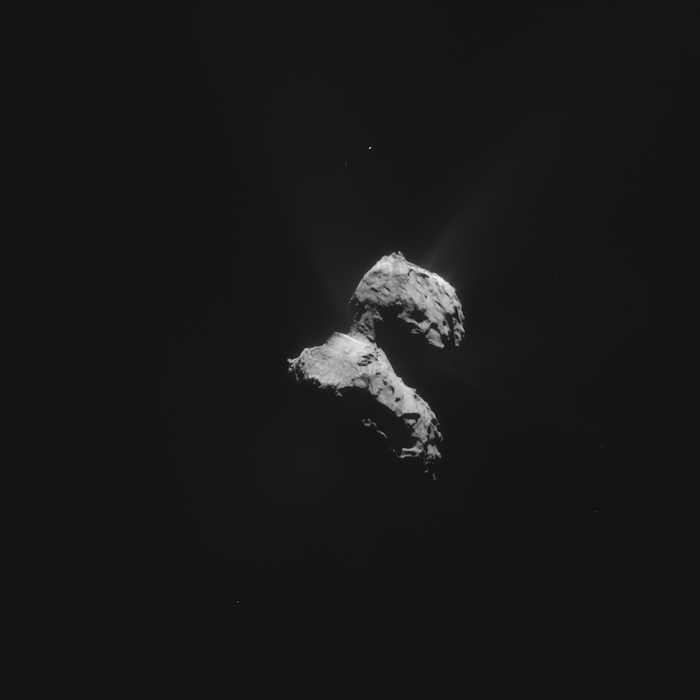
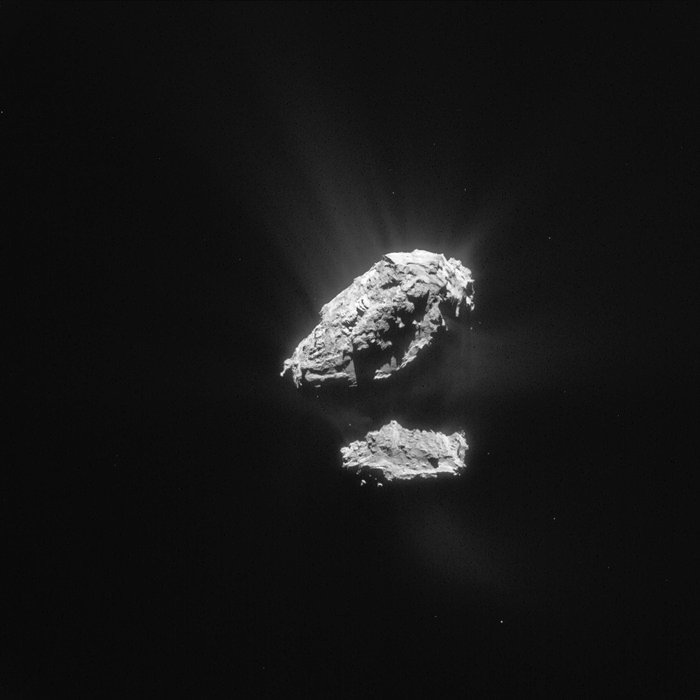
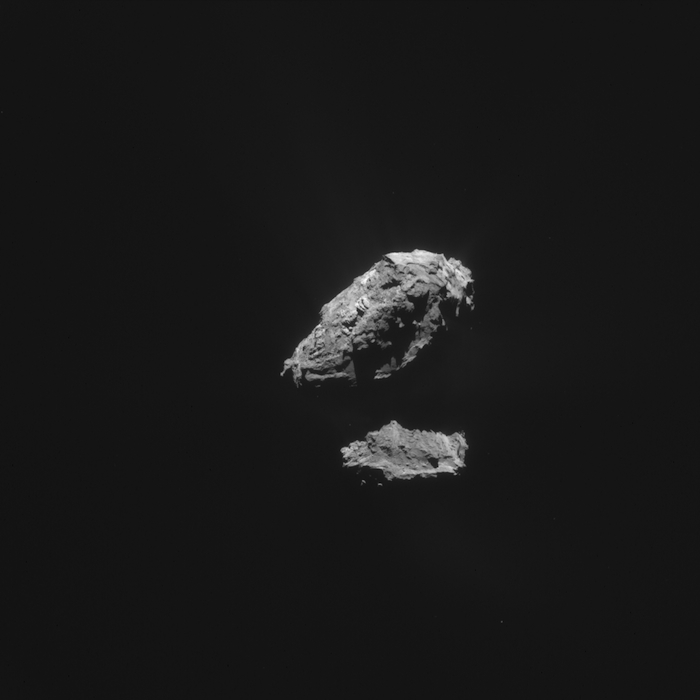
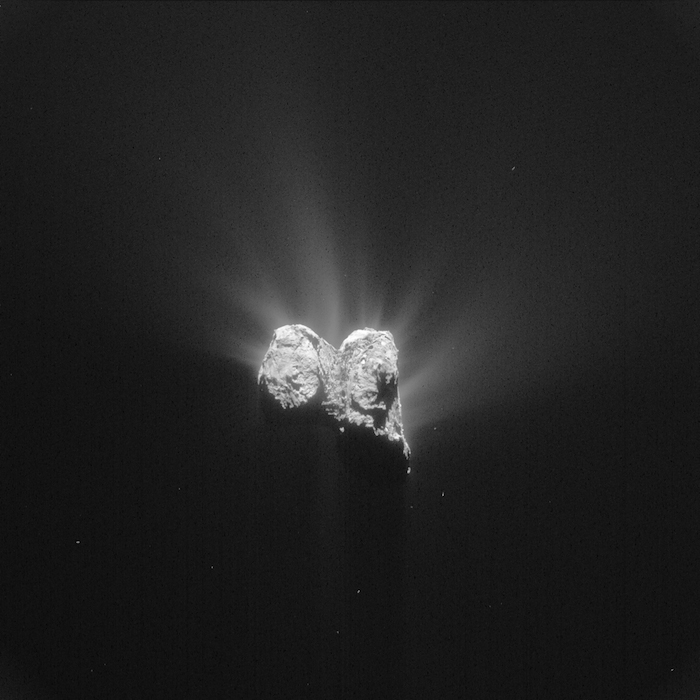
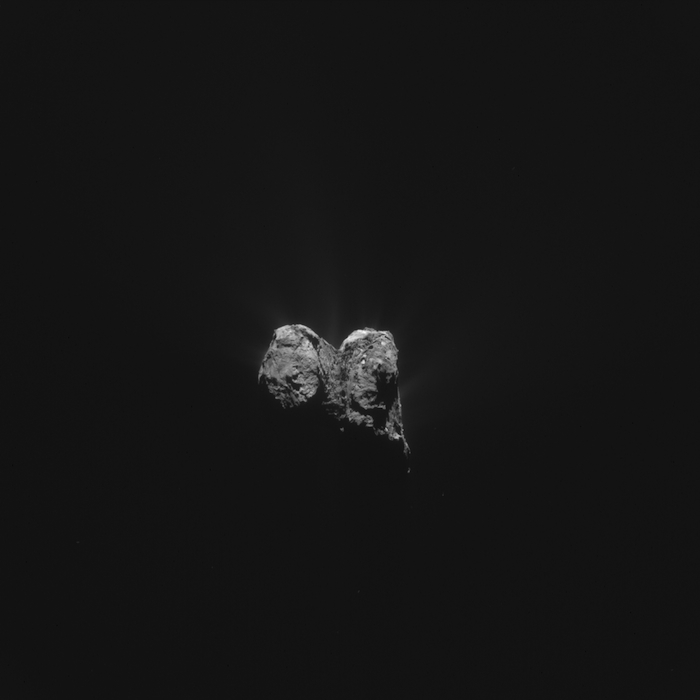
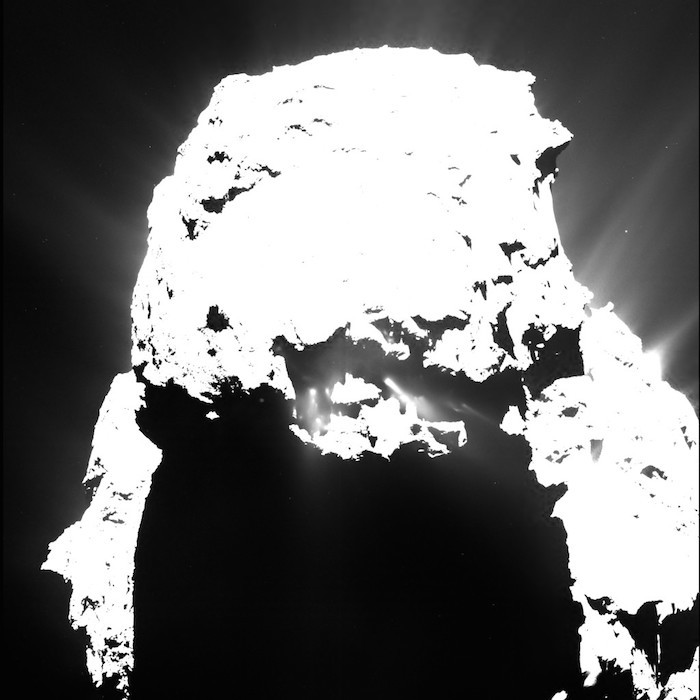
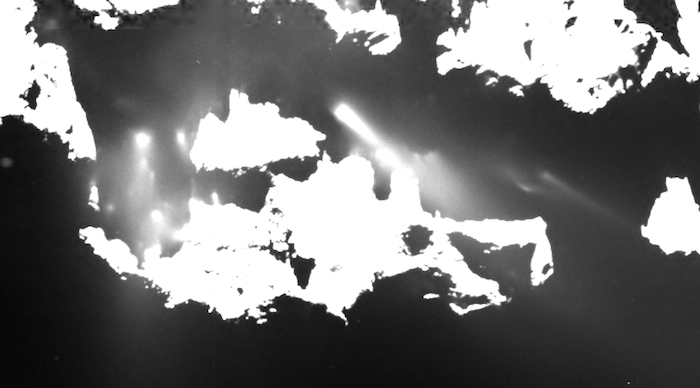
-
In a paper accepted for publication in the journal Astronomy and Astrophysics, scientists report the detections made by Alice from Rosetta’s first four months at the comet, when the spacecraft was between 10 km and 80 km from the centre of the comet nucleus.
For this study, the team focused on the nature of ‘plumes’ of water and carbon dioxide gas erupting from the comet’s surface, triggered by the warmth of the Sun. To do so, they looked at the emission from hydrogen and oxygen atoms resulting from broken water molecules, and similarly carbon atoms from carbon dioxide molecules, close to the comet nucleus.
They discovered that the molecules seem to be broken up in a two-step process.
First, an ultraviolet photon from the Sun hits a water molecule in the comet’s coma and ionises it, knocking out an energetic electron. This electron then hits another water molecule in the coma, breaking it apart into two hydrogen atoms and one oxygen, and energising them in the process. These atoms then emit ultraviolet light that is detected at characteristic wavelengths by Alice.
Similarly, it is the impact of an electron with a carbon dioxide molecule that results in its break-up into atoms and the observed carbon emissions.
“Analysis of the relative intensities of observed atomic emissions allows us to determine that we are directly observing the ‘parent’ molecules that are being broken up by electrons in the immediate vicinity, about 1 km, of the comet’s nucleus where they are being produced,” says Paul Feldman, professor of physics and astronomy at the Johns Hopkins University in Baltimore, and lead author of the paper discussing the results.
By comparison, from Earth or from Earth-orbiting space observatories such as the Hubble Space Telescope, the atomic constituents of comets can only be seen after their parent molecules, such as water and carbon dioxide, have been broken up by sunlight, hundreds to thousands of kilometres away from the nucleus of the comet.
Quelle: ESA
.
Update: 5.06.2015
.
COMETWATCH 21 MAY
This impressive view of Comet 67P/Churyumov-Gerasimenko was captured on 21 May from a distance of 156.8 km from the comet centre. It is a single frame image with a resolution of 13.4 m/pixel, and measures 13.7 km across. The intensities and contrast have been adjusted to emphasise the activity of the comet.
.

Processed image of Comet 67P/C-G taken by Rosetta's NAVCAM on 21 May 2015. Credits: ESA/Rosetta/NAVCAM – CC BY-SA IGO 3.0
Activity is seen all around the nucleus, but in this view is most notable around the head, with many distinct, bright jets streaming from the surface. Intricate patterns of activity are also cast around the neck and against the shadow of the small lobe.
The rather flat face on the comet’s large lobe, comprising parts of Aker and Khepry, dominates the view of the nucleus. The elongate Aten region lies adjacent, with diffuse wisps of activity hanging in front of this shadowed depression.
A fainter cloud of activity is also visible below the shadowed underside of the comet’s large lobe.
Today’s image also makes for a nice comparison with the 26 April entry, which shows the comet in a similar orientation.
The original 1024 x 1024 pixel image is provided below:
.

Quelle: ESA
.
Update: 7.06.2015
.
COMETWATCH 23 MAY
Today's CometWatch entry was taken on 23 May, when Rosetta was 138.1 km from the centre of Comet 67P/Churyumov-Gerasimenko. The single frame NAVCAM image has resolution of 11.8 m/pixel and measures 12.1 km across.
.

Cropped and processed single frame NAVCAM image of Comet 67P/C-G taken on 23 May 2015 from a distance of 138.1 km to the comet centre. Credits: ESA/Rosetta/NAVCAM – CC BY-SA IGO 3.0
.
The image was processed in LightRoom to convey the ever increasing activity of the comet, with swirling outflows of material emanating from various parts of the nucleus.
In this orientation, with the large comet lobe up and the small one down, the neck region remains hidden in shadows. The small lobe is dominated by the rough Anuket region and the sharp edge that separates it from Serqet, which lies mostly out of view to the bottom.
A diffuse glow appears to emanate from a portion of the small lobe that is hidden from sight in this image, suggestive of the activity seen close to Hatmehit, the circular depression on the small lobe, in CometWatch 20 May.
On the large lobe, we see parts of the complex terrain in and surrounding the Atum region. Some of its features are casting shadows on the smoother Anubis region towards the centre of this view..
As shown in previously published images of this portion of 67P/C-G, a curious set of aligned linear features can be seen. Revisit the CometWatch entries taken on 21 March 2015 (and close-up from 24 October 2014) as well as on 16 January 2015, 20 November and 19 September 2014, to view this landmark and its surroundings in more detail and from different orientations.
The original 1024 x 1024 image is provided below:
.

Quelle: ESA
.
Update: 9.06.2015
.
COMETWATCH 1 JUNE
Today’s CometWatch entry was taken on 1 June 2015, from a distance of 209 km from the centre of Comet 67P/Churyumov-Gerasimenko. The image scale is 17.8 m/pixel and the image measures 18.2 km across.
Today’s CometWatch entry was taken on 1 June 2015, from a distance of 209 km from the centre of Comet 67P/Churyumov-Gerasimenko. The image scale is 17.8 m/pixel and the image measures 18.2 km across.
.

Comet 67P/C-G on 1 June. The image has been processed to highlight the comet's activity. Credits: ESA/Rosetta/NAVCAM – CC BY-SA IGO 3.0
The image has been processed to bring out the details of the comet’s activity, which can be seen all around the sunlit side of the comet.
In this orientation the comet’s small lobe is to the left and the large lobe to the right, with much of the southern hemisphere facing towards the spacecraft.
The outline of the rim of the large depression Hatmehit can be seen at the very far left, while at the far right a hint of Imhotep can just be made out. The flat surface at the top of the large lobe in this orientation is in the Aker/Khepry region.
The rugged terrain that faces us has only become visible in more recent months, having previously been cast in shadow. But even at a distance of over 200 km it is clear that this is a complex region with a variety of surface textures.
The original 1024 x 1024 pixel image is provided below:
.

Quelle: ESA
.
SUNSET JETS
Activity on Comet 67P/Churyumov-Gerasimenko continues to rise, with new images from OSIRIS showing that some regions remain active even after nightfall. This report is provided by the OSIRIS team at the Max Planck Institute for Solar System Research (MPS) in Germany.
Rosetta’s scientific camera OSIRIS captured the sunset jets in the Ma’at region of the comet’s small lobe in late April. Images were taken approximately half an hour after the Sun had set over the region and show clearly defined jets of dust escaping into space.
.

Comet 67P/C-G on 25 April 2015, from a distance of approximately 93 kilometres, seen through the narrow-angle OSIRIS camera. The image shows jets emanating from the comet’s small lobe after nightfall. The exposure time was 0.096s. The image is presented to show the details of the jets, rather than the nucleus. Credits: ESA/Rosetta/MPS for OSIRIS Team MPS/UPD/LAM/IAA/SSO/INTA/UPM/DASP/IDA
“Only recently have we begun to observe dust jets persisting even after sunset,” says OSIRIS Principal Investigator Holger Sierks from the Max Planck Institute for Solar System Research (MPS) in Germany.
Until recently, the comet’s activity originated from illuminated areas on the day side. As soon as the Sun set, these jets subsided and did not re-awaken until after sunrise the following day. One recent exception was the event captured on 12 March, which caught the onset of a dust jet at the brink of dawn, in the Imhotep region on the comet’s large lobe.
.

Close-up of the dust jets seen on 25 April 2015 on the comet’s small lobe. Credits: ESA/Rosetta/MPS for OSIRIS Team MPS/UPD/LAM/IAA/SSO/INTA/UPM/DASP/IDA
.
According to the OSIRIS scientists, the sunset jets are another sign of the comet’s increasing activity.
“Currently, 67P is rapidly approaching perihelion in mid-August,” says Sierks. “The solar irradiation is getting more and more intense, the illuminated surface warmer and warmer.”
At the time the image was taken, the comet was 270 million kilometres from the Sun. By the time the comet reaches perihelion on 13 August, the separation will be just 186 million kilometres.
The OSIRIS team think that the comet can store the incoming heat for some time beneath its surface, resulting in sustained activity from these regions even after nightfall.
“While the dust covering the comet’s surface cools rapidly after sunset, deeper layers remain warm for a longer period of time,” says OSIRIS scientist Xian Shi from the MPS, who is studying the sunset jets.
The scientists suspect that the comet’s supply of frozen gases that fuel the comet’s activity exists in these deeper layers.
Previous comet missions, such as Stardust’s flyby of Comet 81P/Wild 2 and Deep Impact’s mission to Comet 9P/Tempel 1, also found evidence of jets sustained on the night side.
“But only the high-resolution images of OSIRIS now allow us to study this phenomenon in detail,” adds Sierks.
About OSIRIS
The scientific imaging system OSIRIS was built by a consortium led by the Max Planck Institute for Solar System Research (Germany) in collaboration with CISAS, University of Padova (Italy), the Laboratoire d'Astrophysique de Marseille (France), the Instituto de Astrofísica de Andalucia, CSIC (Spain), the Scientific Support Office of the European Space Agency (The Netherlands), the Instituto Nacional de Técnica Aeroespacial (Spain), the Universidad Politéchnica de Madrid (Spain), the Department of Physics and Astronomy of Uppsala University (Sweden), and the Institute of Computer and Network Engineering of the TU Braunschweig (Germany). OSIRIS was financially supported by the national funding agencies of Germany (DLR), France (CNES), Italy (ASI), Spain (MEC), and Sweden (SNSB) and the ESA Technical Directorate.
Quelle: ESA
-
Update: 10.06.2015
-
Rosetta deckt Prozesse im Kometenkoma, der Atmosphäre eines Kometen, auf.
Die ESA-Raumsonde Rosetta hat während ihrer andauernden Untersuchungen des Kometen 67P/ Tschurjumow-Gerassimenko eine unerwartete Entdeckung gemacht: Sie hat den Prozess offengelegt, der den rapiden Zerfall von Wasser- und Kohlendioxidmolekülen auslöst, die von der Kometenoberfläche freigegeben werden.
Die Rosetta-Mission der ESA hat den Kometen im August 2014 erreicht. Seitdem umkreist die Raumsonde den Kometen oder fliegt an ihm vorbei – in Entfernungen von acht bis hin zu einigen Hundert Kilometern. Während dieser Flüge sammelt Rosetta, ausgestattet mit elf wissenschaftlichen Instrumenten, Daten zu allen Aspekten der Kometenumwelt.
Eines dieser Geräte, der von der NASA gelieferte Alice-Spektograf, untersucht die chemische Zusammensetzung der Kometenatmosphäre, auch Kometenkoma genannt, in langen Ultraviolett-Wellenlängenbereichen.
In diesen Wellenlängenbereichen ermöglicht es Alice den Wissenschaftlern, einige der am häufigsten vorkommenden Elemente im Universum aufzuspüren. Dazu gehören Wasserstoff, Sauerstoff, Kohlenstoff und Stickstoff. Der Spektograph spaltet das Licht des Kometen in seine verschiedenen Farben, sein Spektrum. So können die Wissenschaftler die chemische Zusammensetzung der Komagase bestimmen.
In einem Paper, das von der Fachzeitschrift Astronomy and Astrophysics zur Publikation angenommen wurde, beschreiben Wissenschaftler die Entdeckungen des Alice-Spektographen, die während Rosettas erster vier Monate am Kometen gemacht wurden. In dieser Zeit war die Raumsonde zwischen zehn und 80 Kilometer vom Mittelpunkt des Kometenkerns entfernt.
Für diese Studie konzentrierte sich das Team auf die Beschaffenheit der Wasser- und Kohlendioxidschwaden, die der Komet an seiner Oberfläche ausspeit. Dieses Hervorbrechen wird von der Wärme der Sonne ausgelöst. Dafür analysierten die Wissenschaftler nahe am Kometenkern die Emissionen von Wasserstoff- und Sauerstoffatomen, die ein Ergebnis aufgebrochener Wassermoleküle sind. Ebenso studierten sie Kohlenstoffatome von Kohlendioxidmolekülen.
Die Wissenschaftler entdeckten, dass die Moleküle wahrscheinlich in einem zweistufigen Prozess aufgebrochen werden.
Zunächst trifft ein ultraviolettes Photon der Sonne ein Wassermolekül im Kometenkoma und ionisiert es. Dabei löst das Photon ein energetisches Elektron aus dem Molekül heraus. Dieses Elektron trifft dann auf ein anderes Wassermolekül im Koma und spaltet es in zwei Wasserstoff- sowie ein Sauerstoffatom auf. Während dieses Prozesses energetisiert das Elektron die Atome. Diese Atome geben dann ultraviolettes Licht ab, dessen charakteristische Wellenlängen vom Alice-Spektographen entdeckt wurden.
Gleichermaßen führt der Aufprall eines Elektrons auf ein Kohlendioxidmolekül zu einem Aufspalten in Atome und die beobachteten Kohlenstoffemissionen.
„Durch die Analyse der relativen Intensitäten der beobachteten atomaren Emissionen konnten wir feststellen, dass wir tatsächlich die ‚Eltern’-Moleküle beobachten, die von Elektronen in unmittelbarer Nähe des Kometenkerns, etwa einen Kilometer von ihm entfernt, aufgebrochen werden, und zwar an dem Ort, an dem sie entstehen“, sagt Paul Feldman, Professor für Physik und Astronomie an der Johns Hopkins University in Baltimore. Feldman ist der Erstautor des Papers, in dem die Ergebnisse diskutiert werden.
Von der Erde oder von erdumkreisenden Observatorien wie dem Hubble-Weltraumteleskop aus können die atomaren Bestandteile von Kometen dagegen nur beobachtet werden, nachdem die Elternmoleküle (zum Beispiel Wasser oder Kohlendioxid) vom Sonnenlicht aufgebrochen worden sind – Hunderte bis Tausende Kilometer vom Kometenkern entfernt.
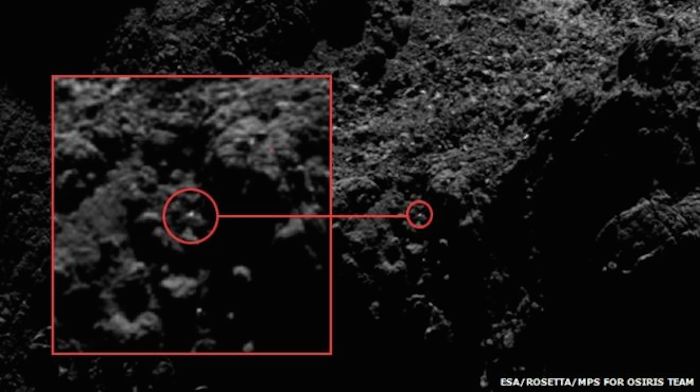


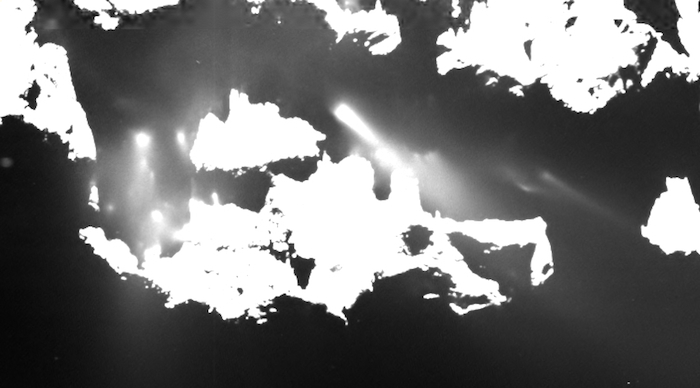
„Diese Entdeckung, über die wir jetzt berichten, kam ziemlich unerwartet“, sagt Alice-Projektleiter Alan Stern, Associate Vice President der Abteilung Weltraumwissenschaften und -technik am Southwest Research Institute (SwRI).
„Es zeigt uns auf, wie wichtig es ist, zu Kometen zu fliegen, um sie aus der Nähe analysieren zu können. Denn diese Entdeckung wäre niemals von einem Observatorium auf der Erde oder in einem Erdorbit gemacht worden, weder von einem existierenden noch von einem geplanten. Und diese Entdeckung verändert unser Wissen über Kometen fundamental.“
„Durch die Analyse der Emissionen von Wasserstoff- und Sauerstoffatomen, die von den Wassermolekülen abgespalten werden, können wir außerdem die Lage sowie die Struktur der Wasserschwaden, die aus der Kometenoberfläche herausbrechen, bestimmen“, sagt Mitautor Joel Parker, stellvertretender Direktor der Abteilung Weltraumwissenschaften und -technik am SwRI in Boulder, Colorado.
Das Wissenschaftler-Team vergleicht diese Aufspaltung der Moleküle mit dem Prozess, der für die Schwaden auf Jupiters vereistem Mond Europa vorgeschlagen wurde – mit dem Unterschied, dass die Elektronen am Kometen von Solarphotonen produziert werden. Die Elektronen auf Europa kommen aus Jupiters Magnetosphäre.
Die Ergebnisse des Alice-Spektographen werden von Daten, die andere Rosetta-Geräte gesammelt haben, bekräftigt. Zu nennen sind hier MIRO, ROSINA und VIRTIS, die in der Lage sind, die vielen verschiedenen Komabestandteile sowie deren Variationen im Zeitverlauf zu analysieren, sowie Geräte zur Partikelerkennung wie RPC-IES.
„Diese frühen Ergebnisse des Alice-Spektografen zeigen, wie wichtig es ist, einen Kometen in unterschiedlichen Wellenlängenbereichen und mit unterschiedlichen Technologien zu untersuchen, um so verschiedene Aspekte der Kometenumwelt zu erforschen“, sagt Matt Taylor, Rosetta-Projektwissenschaftler der ESA.
„Wir verfolgen derzeit aktiv, wie sich der Komet entwickelt, während er auf seinem Orbit der Sonne immer näher kommt, bis er im August das Perihel erreicht. Wir sehen, wie die Schwaden wegen der zunehmenden Sonnenwärme immer aktiver werden und untersuchen die Auswirkungen der Kometeninteraktion mit dem Sonnenwind.“
Quelle: ESA
-
Update: 12.06.2015
.
Best candidates' for lost Philae comet lander

The European Space Agency (Esa) has released some pictures that may include its lost comet lander, Philae.
Whether that really is the case is far from certain, however.
The features of interest in the images are on the scale of a few bright pixels and could very easily just be a trick of the light.
Philae was dropped on to the surface of Comet 67P by its mothership Rosetta in November last year, and has not been heard from since its battery ran flat.
The washing-machine-sized robot bounced a good kilometre from its intended touchdown point, hence the doubts about its current precise whereabouts on the 4km-wide icy dirt-ball.
Mission teams have a very good idea of where Philae ought to be - inside a patch of terrain measuring perhaps a few tens of metres across. But getting the photographic evidence to prove it is there has been very challenging.
Rosetta acquired a series of pictures of the suspected resting region back in December, and scientists have been poring over the data ever since.
.

They have been looking for differences in this image-set compared with pictures taken before the landing, and Thursday's release from Esa represents what can only be described as "the best candidates" for Philae. One is rated higher than the others, but even this cannot be promoted with particularly high confidence, agency officials have told the BBC.
Even after some smart processing techniques were applied, it is still just a bright splodge. Esa has rendered a movie that zooms in on this top candidate (MOV) to make it easier for people to discern the feature being discussed.
Stephan Ulamec, the lander manager with the German space agency, said recently: "In the best images we have after the landing, with the correct illumination and taken from an altitude of 20km - the lander would be in the range of two-times-three or three-times-three pixels. And this is exactly the problem: it's not very distinct. We have to assume there is some shadowing effect on the lander that will camouflage it.
"And, yes, the later in the evening and the more wine you drink - the more landers you're able to identify in this terrain," he memorably joked at this year's European Geosciences Union General Assembly in Vienna in April.
.

Philae bounced more than 1,200m across the surface before stopping in a ditch
Before it lost power, Philae itself returned images of its surroundings, which showed it was in some kind of ditch. The location, dubbed Abydos, is on the "head" of the duck-shaped comet.
High walls were blocking sunlight from reaching Philae's solar panels, denying the robot the ability to charge its battery.
The mission teams must now hope that those illuminations conditions will improve as Comet 67P moves closer to the Sun in the course of the next few weeks. They should. And if Philae can muster enough charge to boot up, the orbiting Rosetta will be listening for even the briefest of radio communications.
The first contacts - if they come - will be short because the battery will almost immediately die again as the transmitter equipment is fired up. But in time - perhaps by July - Philae could be getting enough intense sunlight to generate a useful amount of electricity.
The big concern, however, is the cold. For many of the lander's components this is not a problem, but there will be electronics that have experienced temperatures in the past few months that are below their "qualified" limits. This will include the onboard computer and the communications unit, both of which sit inside a so-called "warm compartment".
"A problem one may face with these low temperatures is some thermal stresses on the electronics boards, and they may damage soldering points," Dr Ulamec explained.
"All the instruments and mechanisms that are outside the warm compartment - they are qualified for very low temperatures because we were expecting those even if we had landed in the planned landing location."
Mission teams had the idea to send Rosetta on a quick, close flyby of the suspected resting place this month, to acquire new images with a higher resolution than those featured on this page. But this possibility has long since been abandoned. So much dust is coming off the active comet that Rosetta's navigation systems get confused if the probe ventures too close.
Rosetta has been pulled back from 67P and currently keeps a watching brief from a distance of about 100km.
The probe's distance from Earth is about 309 million km, and about 218 million km from the Sun.
Quelle: BBC
.
Update: 14.06.2015
.
Rosetta-Komet: Staubfontänen in der Nacht
Auch nach Einbruch der Dunkelheit bleibt der Komet 67P/Churyumov-Gerasimenko aktiv und spuckt Staubfontänen ins All.
.
Wenn die Nacht anbricht auf dem Rosetta-Kometen 67P/Churyumov-Gerasimenko, bleibt der bizarr geformte Körper weiterhin aktiv. Das belegen neue Aufnahmen der Ma’at Region auf dem „Kopf“ des Kometen, die OSIRIS, das wissenschaftliche Kamerasystem an Bord der Raumsonde Rosetta, am 25. April dieses Jahres eingefangen hat. Sie entstanden etwa eine halbe Stunde, nachdem die Sonne über dieser Region untergegangen war, und zeigen mehrere klar unterscheidbare Staubfontänen, die ins All entweichen. Forscher des OSIRIS-Teams glauben, dass die zunehmende Erwärmung des Kometen für das neu beobachtete Phänomen verantwortlich ist.
„Staubfontänen, die auch nach Sonnenuntergang weiter bestehen, beobachten wir erst seit Kurzem“, sagt OSIRIS-Teamleiter Holger Sierks vom Max-Planck-Institut für Sonnensystemforschung (MPS) in Göttingen. In den vergangenen Monaten ging die Aktivität des Kometen von beleuchteten Flächen auf der Tagseite aus. Sobald es dunkelte, kamen die Fontänen zum Erliegen und erwachten erst nach Sonnenaufgang wieder zu neuem Leben. Eine Ausnahme bildet eine Aufnahme vom 12. März 2015, die das Einsetzen einer Staubfontäne während des Morgengrauens zeigt.
Die Fontänen, die nun auch nach Sonnenuntergang auftreten, sind nach Ansicht der OSIRIS-Wissenschaftler ein weiteres Zeichen für die zunehmende Aktivität des Kometen. „Derzeit nähert sich 67P rasch seinem sonnennächsten Punkt, den er bereits Mitte August erreicht“, so Sierks. Zum Zeitpunkt der Aufnahme trennten nur noch etwa 270 Millionen Kilometer Sonne und Komet. „Die Sonneneinstrahlung wird immer intensiver, die beleuchtete Oberfläche immer wärmer“, fügt Sierks hinzu.
.

Detailaufnahme der Staubfontänen.
ESA/Rosetta/MPS for OSIRIS Team MPS/UPD/LAM/IAA/SSO/INTA/UPM/DASP/IDA
.
Erste Modellrechnungen deuten darauf hin, dass der Komet unter seiner Oberfläche diese Wärme für einige Zeit speichern kann. „Während der oberflächliche Staub nach Sonnenuntergang rasch abkühlt, bleiben tiefer liegende Schichten länger warm“, erklärt OSIRIS-Wissenschaftlerin Xian Shi vom MPS, die die nächtlichen Fontänen untersucht. Dort vermuten Rosetta-Wissenschaftler den Vorrat an gefrorenen Gasen, der die Aktivität des Kometen speist.
Bereits ältere Kometenmissionen wie Stardust zum Kometen 81P/Wild 2 und Deep Impact zum Kometen 9P/Tempel 1 hatten Hinweise auf Fontänen geliefert, die auf der Nachtseite entstehen. „Doch erst die hochaufgelösten Bilder von OSIRIS erlauben es uns nun, dieses Phänomen detailliert zu studieren“, so Sierks.
Rosetta ist eine Mission der Europäischen Weltraumagentur ESA mit Beiträgen der Mitgliedsstaaten und der amerikanischen Weltraumagentur NASA. Rosettas Landeeinheit Philae wurde von einem Konsortium unter Leitung des Deutschen Zentrums für Luft- und Raumfahrt (DLR), des Max-Planck-Instituts für Sonnensystemforschung (MPS) und der französischen und italienischen Weltraumagentur (CNES und ASI) zur Verfügung gestellt. Rosetta ist die erste Mission in der Geschichte, die einen Kometen anfliegt, ihn auf seinem Weg um die Sonne begleitet und eine Landeeinheit auf seiner Oberfläche absetzt.
Das wissenschaftliche Kamerasystem OSIRIS wurde von einem Konsortium unter Leitung des Max-Planck-Instituts für Sonnensystemforschung in Zusammenarbeit mit CISAS, Universität Padova (Italien), Laboratoire d'Astrophysique de Marseille (Frankreich), Instituto de Astrofísica de Andalucia, CSIC (Spanien), Scientific Support Office der ESA (Niederlande), Instituto Nacional de Técnica Aeroespacial (Spanien), Universidad Politéchnica de Madrid (Spanien), Department of Physics and Astronomy of Uppsala University (Schweden) und dem Institut für Datentechnik und Kommunikationsnetze der TU Braunschweig gebaut. OSIRIS wurde finanziell unterstützt von den Weltraumagenturen Deutschlands (DLR), Frankreichs (CNES), Italiens (ASI), Spaniens (MEC) und Schwedens (SNSB).
Quelle: MAX-PLANCK-GESELLSCHAFT, MÜNCHEN
5200 Views
